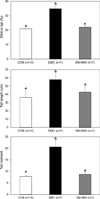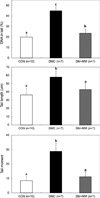Abstract
Purpose
Water is magnetically charged upon contact with a magnet. Although magnetic water products have been promoted since the 1930's, they have not received wide acceptance since their effectiveness is still in question; however, some have reported their therapeutic effects on the body, especially the digestive, nervous, and urinary systems.
Methods
In this study, the effect of magnetized water on glycemic control of 14 diabetic mice (CB57BK/KsJ-db/db) in comparison with 10 control mice (CB57BK/KsJ-db/+(db/+)) was investigated. Seven diabetic control (DMC) mice and seven diabetic mice + magnetized water (DM+MW) were kept for 16 weeks, followed by intraperitoneal glucose tolerance test (IPGTT). Weekly blood glucose was measured from tail veins. Blood obtained from heart puncture was used for HbA1c analysis.
Results
Blood glucose level showed a significant difference starting from the 10th week of study (496.1 ± 10.2 mg/dl in DMC vs. 437.9 ± 76.9 mg/dl in DM+MW). Blood glucose followed by IPGTT showed no significant difference between groups at 0, 30, 60, 90, and 120 min, although glucose level at 180 min was significantly reduced in DM+MW mice. Plasma insulin level in DM+MW groups was only 39.5% of that of DMC groups (5.97 ± 1.69 ng/ml in DMC vs. 2.36 ± 0.94 ng/ml in DM+MW). Levels of HbA1c were 12.4% and 9.7% in DMC and DM+MW groups, respectively.
Figures and Tables
Fig. 1
Effect of magnetized water on blood glucose in db/db mice. Mean ± SD. Abbreviations: CON, control (n = 10); DMC, dia betes mellitus control (n = 7); DM+MW, DM+Magnetic water (n = 7). Values within a group with different alphabet are significantly different at p < 0.05 by Duncan's multiple range test.

Fig. 2
Effect of magnetized water on area under the blood glucose curve after oral glucose tolerance test in db/db mice. Mean ± SD. Abbreviations: CON, control (n = 10); DMC, diabetes mellitus control (n = 7); DM+MW, DM+Magnetic water (n = 7); AUC, area under the curve. Values with different alphabet are significantly different at p < 0.05 by Duncan's multiple range test.

Fig. 3
Effect of magnetized water on plasma insulin in db/db mice. Mean ± SD. Abbreviations: CON, control (n = 10); DMC, diabetes mellitus control (n = 7); DM+MW, DM+Magnetic water (n = 7). Bar with different letters are significantly different at p < 0.05 after Duncan’s multiple range test.

Fig. 4
Effect of magnetized water on blood HbA1c in db/db mice Mean ± SD. Abbreviations: CON, control (n = 10); DMC, diabetes mellitus control (n = 7); DM+MW, DM+Magnetic water (n = 7). Bar with different letters are significantly different at p < 0.05 after Duncan’s multiple range test.

Fig. 5
Protective effect of magnetized water on blood DNA damages in db/db mice. Mean ± SD. Abbreviations: CON, control (n = 10); DMC, diabetes mellitus control (n = 7); DM+MW, DM+Magnetic water (n = 7). Bar with different letters are significantly different at p < 0.05 after Duncan’s multiple range test.

Fig. 6
Protective effect of magnetized water on liver DNA damages in db/db mice. Mean ± SD. Abbreviations: CON, control (n = 10); DMC, diabetes mellitus control (n = 7); DM+MW, DM+Magnetic water (n = 7). Bar with different letters are significantly different at p < 0.05 after Duncan’s multiple range test.

References
1. Korean Diabetes Association. Korean Diabetes Research Foundation. Diabetes fact sheet in Korea 2016. Seoul: Korean Diabetes Association;2016.
2. Dandona P, Thusu K, Cook S, Snyder B, Makowski J, Armstrong D, Nicotera T. Oxidative damage to DNA in diabetes mellitus. Lancet. 1996; 347(8999):444–445.

3. Lee HJ, Kang MH. Effect of the magnetized water supplementation on blood glucose, lymphocyte DNA damage, antioxidant status, and lipid profiles in STZ-induced rats. Nutr Res Pract. 2013; 7(1):34–42.

4. Park JH, Sung KS, Kim SS, Shim GS, Han CK. Effects of puffed and fermented red ginseng on blood glucose-related biomarkers in streptozotocin-induced diabetic rats. J Korean Soc Food Sci Nutr. 2012; 41(5):630–637.

5. Mozaffari MS, Baban B, Abdelsayed R, Liu JY, Wimborne H, Rodriguez N, Abebe W. Renal and glycemic effects of high-dose chromium picolinate in db/db mice: assessment of DNA damage. J Nutr Biochem. 2012; 23(8):977–985.

6. Shirpoor A, Ansari MH, Salami S, Pakdel FG, Rasmi Y. Effect of vitamin E on oxidative stress status in small intestine of diabetic rat. World J Gastroenterol. 2007; 13(32):4340–4344.

7. Mitri J, Dawson-Hughes B, Hu FB, Pittas AG. Effects of vitamin D and calcium supplementation on pancreatic β cell function, insulin sensitivity, and glycemia in adults at high risk of diabetes: the calcium and vitamin D for diabetes mellitus (CaDDM) randomized controlled trial. Am J Clin Nutr. 2011; 94(2):486–494.

8. Roussel AM, Kerkeni A, Zouari N, Mahjoub S, Matheau JM, Anderson RA. Antioxidant effects of zinc supplementation in Tunisians with type 2 diabetes mellitus. J Am Coll Nutr. 2003; 22(4):316–321.

9. Lee CH, Kim J, Kwon J, Youn Y, Kim YS. Instant gruel from colored barley and oats for improving diabetic conditions. J Korean Soc Food Sci Nutr. 2013; 42(6):885–891.

10. Lee SJ, Shin JH, Ju JC, Kang SK, Sung NJ. Hypoglycemic and hypolipidemic effects of orostachys japonicus with medicinal herbs in streptozotocin-induced diabetic rats. J Korean Soc Food Sci Nutr. 2013; 42(4):587–594.

11. Lee BR, Koh KO, Park PS. Antihyperglycemic effects of green tea extract on alloxan-induced diabetic and OLETF rats. J Korean Soc Food Sci Nutr. 2007; 36(6):696–702.

12. Hininger-Favier I, Benaraba R, Coves S, Anderson RA, Roussel AM. Green tea extract decreases oxidative stress and improves insulin sensitivity in an animal model of insulin resistance, the fructose-fed rat. J Am Coll Nutr. 2009; 28(4):355–361.

14. Johnson KE, Sanders JJ, Gellin RG, Palesch YY. The effectiveness of a magnetized water oral irrigator (Hydro Floss) on plaque, calculus and gingival health. J Clin Periodontol. 1998; 25(4):316–321.
15. Ma YL, Ren H, Ren S, Zhen EK, Hao G, Zhao YW. A study of the effect of magnetized water on enzyme activities by potentiometric enzyme electrode method. J Tongji Med Univ. 1992; 12(4):193–196.
16. Zhang YS, Wu HW. Effect of magnetic water on urinary calculi--an experimental and clinical study. Z Urol Nephrol. 1987; 80(9):517–523.
17. Zhang YS, Wu HW. Effect of magnetized water on urinary calculi: an experimental and clinical study. Acta Acad Med Wuhan. 1984; 4(1):31–37.
18. Hafizi L, Gholizadeh M, Karimi M, Hosseini G, Mostafavi-Toroghi H, Haddadi M, Rezaiean A, Ebrahimi M, Emami Meibodi N. Effects of magnetized water on ovary, pre-implantation stage endometrial and fallopian tube epithelial cells in mice. Iran J Reprod Med. 2014; 12(4):243–248.
19. Iorio R, Delle Monache S, Bennato F, Di Bartolomeo C, Scrimaglio R, Cinque B, Colonna RC. Involvement of mitochondrial activity in mediating ELF-EMF stimulatory effect on human sperm motility. Bioelectromagnetics. 2011; 32(1):15–27.

20. Lee HJ, Jo HR, Jeon EJ, Kang MH. Effect of the Magnetized water supplementation on lymphocyte DNA damage in mice treated with diethylnitrosamine. Korean J Nutr. 2010; 43(6):570–577.

21. Singh NP, McCoy MT, Tice RR, Schneider EL. A simple technique for quantitation of low levels of DNA damage in individual cells. Exp Cell Res. 1988; 175(1):184–191.

22. Pitozzi V, Giovannelli L, Bardini G, Rotella CM, Dolara P. Oxidative DNA damage in peripheral blood cells in type 2 diabetes mellitus: higher vulnerability of polymorphonuclear leukocytes. Mutat Res. 2003; 529(1-2):129–133.

23. Dinçer Y, Akçay T, Alademir Z, Ilkova H. Assessment of DNA base oxidation and glutathione level in patients with type 2 diabetes. Mutat Res. 2002; 505(1-2):75–81.

24. Xu YB, Sun SY. Effect of stable weak magnetic field on Cr(VI) bio-removal in anaerobic SBR system. Biodegradation. 2008; 19(3):455–462.

25. Gonet B. Influence of constant magnetic fields on certain physiochemical properties of water. Bioelectromagnetics. 1985; 6(2):169–175.

26. Liboff AR, Cherng S, Jenrow KA, Bull A. Calmodulin-dependent cyclic nucleotide phosphodiesterase activity is altered by 20 microT magnetostatic fields. Bioelectromagnetics. 2003; 24(1):32–38.
27. Kim MJ, Jung KH, Uhm YK, Leem KH, Kim HK. Preservative effect of electrolyzed reduced water on pancreatic beta-cell mass in diabetic db/db mice. Biol Pharm Bull. 2007; 30(2):234–236.

28. Lazalde-Ramos BP, Zamora-Perez AL, Sosa-Macías M, Guerrero-Velázquez C, Zúñiga-González GM. DNA and oxidative damages decrease after ingestion of folic acid in patients with type 2 diabetes. Arch Med Res. 2012; 43(6):476–481.

29. Lodovici M, Giovannelli L, Pitozzi V, Bigagli E, Bardini G, Rotella CM. Oxidative DNA damage and plasma antioxidant capacity in type 2 diabetic patients with good and poor glycaemic control. Mutat Res. 2008; 638(1-2):98–102.

30. Agarwal A, Aponte-Mellado A, Premkumar BJ, Shaman A, Gupta S. The effects of oxidative stress on female reproduction: a review. Reprod Biol Endocrinol. 2012; 10(1):49–79.

31. Naher ZU, Ali M, Biswas SK, Mollah FH, Fatima P, Hossain MM, Arslan MI. Effect of oxidative stress in male infertility. Mymensingh Med J. 2013; 22(1):136–142.
32. Sueda M, Katsuki A, Nonomura M, Kobayashi R, Tanimoto Y. Effects of high magnetic field on water surface phenomena. J Phys Chem C Nanomater Interfaces. 2007; 111(39):14389–14393.

33. Cho YI, Lee SH. Reduction in the surface tension of water due to physical water treatment for fouling control in heat exchangers. Int Commun Heat Mass Transf. 2005; 32(1-2):1–9.

34. Nakagawa J, Hirota N, Kitazawa K, Shoda M. Magnetic field enhancement of water vaporization. J Appl Phys. 1999; 86(5):2923–2925.

35. Wang D, Cheng X, Yan X. Effect of magnetized liquor on free radical metabolism in the heart of mice. Chin J Med Phys. 2002; 19(4):243–244.
36. Raymond-Whish S, Mayer LP, O'Neal T, Martinez A, Sellers MA, Christian PJ, Marion SL, Begay C, Propper CR, Hoyer PB, Dyer CA. Drinking water with uranium below the U.S. EPA water standard causes estrogen receptor-dependent responses in female mice. Environ Health Perspect. 2007; 115:1711–1716.

37. Shah D, Nagarajan N. Luteal insufficiency in first trimester. Indian J Endocrinol Metab. 2013; 17(1):44–49.

38. Lu J, Mao Y, Yang Y, Wang Y, Shi Y, Zhou O. Influence of magnetized water on the experimental hyperlipemia and atherosclerosis in rabbits. Shanghai Lab Anim Sci. 2000; 20:45–51.
39. Hafizi L, Sazgarnia A, Mousavifar N, Karimi M, Ghorbani S, Kazemi MR, Emami Meibodi N, Hosseini G, Mostafavi Toroghi H. The effect of extremely low frequency pulsed electromagnetic field on in vitro fertilization success rate in N MRI mice. Cell J. 2014; 15(4):310–315.




 PDF
PDF ePub
ePub Citation
Citation Print
Print





 XML Download
XML Download